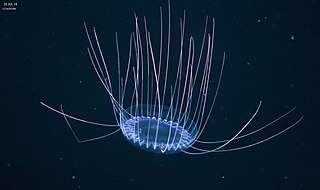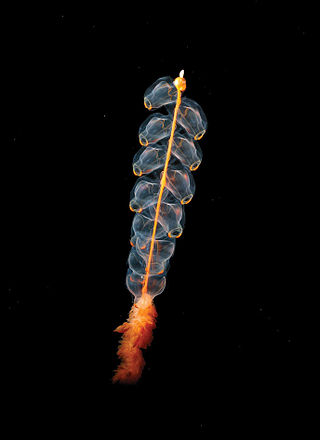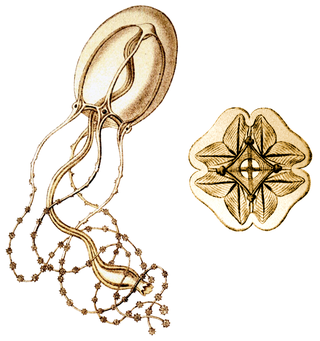
Ernst Heinrich Philipp August Haeckel was a German zoologist, naturalist, eugenicist, philosopher, physician, professor, marine biologist and artist. He discovered, described and named thousands of new species, mapped a genealogical tree relating all life forms and coined many terms in biology, including ecology, phylum, phylogeny, and Protista. Haeckel promoted and popularised Charles Darwin's work in Germany and developed the influential but no longer widely held recapitulation theory claiming that an individual organism's biological development, or ontogeny, parallels and summarises its species' evolutionary development, or phylogeny.

The Noctilucales are an order of marine dinoflagellates. They differ from most others in that the mature cell is diploid and its nucleus does not show a dinokaryotic organization. They show gametic meiosis.
The tree of life or universal tree of life is a metaphor, conceptual model, and research tool used to explore the evolution of life and describe the relationships between organisms, both living and extinct, as described in a famous passage in Charles Darwin's On the Origin of Species (1859).
The affinities of all the beings of the same class have sometimes been represented by a great tree. I believe this simile largely speaks the truth.

Solmissus, or dinner plate jellyfish, is a genus of hydrozoans. Its species are unique among cnidarians in that they actively hunt for prey as opposed to passively waiting for plankton to pass by. They are found in the deep waters of Monterey Bay, California. They are most likely to be found in the deep sea, mid water. They grow to be 20 cm (7.9 in) in diameter. These hydrozoans feed on gelatinous zooplankton, including salps and doliolids, ctenophores, jellyfish, and copepods. However, Solmissus may be limited to feeding on soft-bodied prey by the type of nematocysts on their tentacles (Mills).
Lovenellidae is a family of hydrozoans. Their hydroids live together in upright stolonal or sympodial colonies, and their gonophores are pedunculate free-roaming medusae. The relationships of this fairly small but distinctive radiation to other members of the order Leptothecata are not well understood at present.

Agalmatidae, or Agalmidae, is a family of siphonophores.
Solmarisidae is a family of hydrozoans in the order Narcomedusae. The name is sometimes spelled "Solmaridae".

Limnomedusae is an order of hydrozoans.

Rhizostomatidae is a family of cnidarians in the class Scyphozoa.

Aeginura is a genus of hydrozoans in the family Aeginidae.

Sarsia is a genus of hydrozoan in the family Corynidae.

Aglantha is a genus of deep-sea hydrozoans of the family Rhopalonematidae.

Eleutheria is a genus of hydrozoans belonging to the family Cladonematidae.

Orchistoma is a genus of cnidarians belonging to the monotypic family Orchistomatidae.
Pteronema is a genus of hydrozoans belonging to the monotypic family Pteronemidae.
Pseudaegina is a genus of cnidarians belonging to the monotypic family Pseudaeginidae.
Codonium is a genus of hydrozoans belonging to the family Corynidae.
Staurodiscus is a genus of hydrozoans belonging to the family Hebellidae.
Modeeria is a genus of hydrozoans belonging to the family Tiarannidae.

Staurostoma is a genus of cnidarians of the family Laodiceidae. The genus contains two described species.











